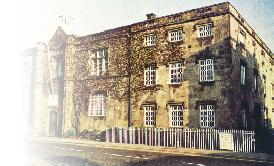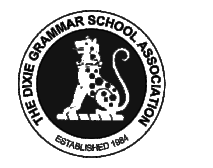


A close neighbour, Wrightson Munday, owner of Osbaston Hall, just down the road, was equally determined that his wagons should use a path crossing Dixie’s land. Dressed as a waggoner he made his way onto the Dixie estate. Challenged by Dixie, the two fought, Munday coming off worst and retreating. Later, when Sir Wolstan was presented to King George 2nd as Dixie of Bosworth, the King enquired “Bosworth? Bosworth? Big battle at Bosworth wasn’t it?” “Yes, sire. But I thrashed him” replied Dixie.
In 1732 he appointed Samuel Johnson to the position of Usher. According to Johnson’s biographer, James Boswell, this was the unhappiest period of his life. The 4th Baronet died in 1767 and was succeeded by his son.
Sir Wolstan Dixie, 5th Baronet died unmarried on January 12th 1806 and was succeeded by his cousin Sir Beaumont Joseph Dixie Bart. R.N. He was a prisoner of war in France from 1802 until 1814. He died unmarried at Bosworth Hall six days after his return from France and was succeeded by his brother, Sir Willoughby Wolstan Dixie, the 7th Baronet. He died in 1827 and is remembered for his curious rhyming Last Will and Testament.
Another Sir Willoughby Wolstan Dixie succeeded him as the 8th Baronet.
The 9th Baronet, Sir Alexander Dixie, was a captain in the Royal Navy and served on HMS Victory under Nelson in 1804. He was second in command of the Phoebe in the Battle of Trafalgar. He died in 1857 and is buried in St. Peter’s Churchyard, Market Bosworth.
He was succeeded by Sir Alexander Beaumont Churchill Dixie, a Doctor of Medicine and a Justice of the Peace for Leicestershire.
The eleventh Baronet, also Sir Alexander Beaumont Churchill Dixie, had a temperament that was neither rationalistic nor tolerant. He was married to Lady Florence Douglas, the well known travel writer and feminist.
He was succeeded by his eldest son, Sir George Douglas Dixie, the 12th Baronet, who after serving in the Royal Navy as a midshipman, was commissioned into the King's Own Scottish Borderers in 1895 and married Margaret Lindsay, daughter of Sir A. Jardine, 8th Baronet. He was promoted a temporary captain in the 5th Battalion the KOSB, 26 November 1914. He died in 1948 and was succeeded by his son.
Sir Wolstan Dixie, 13th Baronet, who married twice and had two daughters. He was a school governor during the 1950s and 60s and attended many functions at the School. When he died in 1975, with him having no sons, the title became extinct. The 13th Baronet wrote an autobiography, published in 1972, called “Is it True What They Say About Dixie? The Second Battle of Bosworth”.
She knew that this former Lord Mayor, who had been one of her most loyal supporters, was interested in the spread of education, as were all of the Tudors. Moreover, she had a special fondness for Bosworth, since it was there that her grandfather had gained the crown in 1485. And surely Bosworth could be classed as a Royal School due to its connection with King Egbert?
The Queen appointed local men as governors including the rector and the churchwardens.
She added the proviso that if they should fail in their duties then The Bishop of
Lincoln, a powerful Leicestershire landowner should nominate the governors. The right
to nominate the Master and Under-
In 1604 Dixie was knighted, not by a Tudor queen, who died in 1603, but by the first of the Stuart monarchs, James. In 1614 he became High Sheriff of Leicestershire and was elected to parliament representing the county, probably in 1625.
His son, yet another Wolstan, was described as “a fervent Royalist” . It is recorded that “at the breaking out of the rebellion in 1641, he appeared early in the defence of his king and was a great sufferer for the royal cause. When the gentry of Leicester contributed £25,642 for his majesty, Wolstan gave of himself towards that sum £1835; for which signal service he received a warrant for a baronet’s patent; but through the confusion of the times it was not taken out until after the Restoration”.
Wolstan had also sent his private regiment to Ulster in the monarch’s cause. This is the reason for the “Bloody Hand of Ulster”, recognised as the badge of a baronet, appearing on his coat of arms. The baronetcy is accepted as being instituted in 1660. The Baronet’s first wife, Barbara, was the daughter Sir Henry Beaumont, Bart. who’s family claimed descent from the House of Plantagenet. Yet another connection of the Dixie family to Bosworth. Sir Wolstan died in 1682.
Sir Beaumont Dixie, his son, the 2nd. Baronet, was responsible for the building of Bosworth Hall. He was succeeded by his eldest son, the 3rd Baronet, another Sir Wolstan. The 4th Baronet, was yet another Sir Wolstan!
He was the first of the real characters of the family. His first wife, Anna, was the heiress of Tobias Freer, the Governor of Barbados. She died in 1739 and Sir Wolstan took two further wives! He was by all accounts a boorish, self opinionated autocrat with a penchant for brawling! Legend has it that he objected strongly to anyone crossing his land.